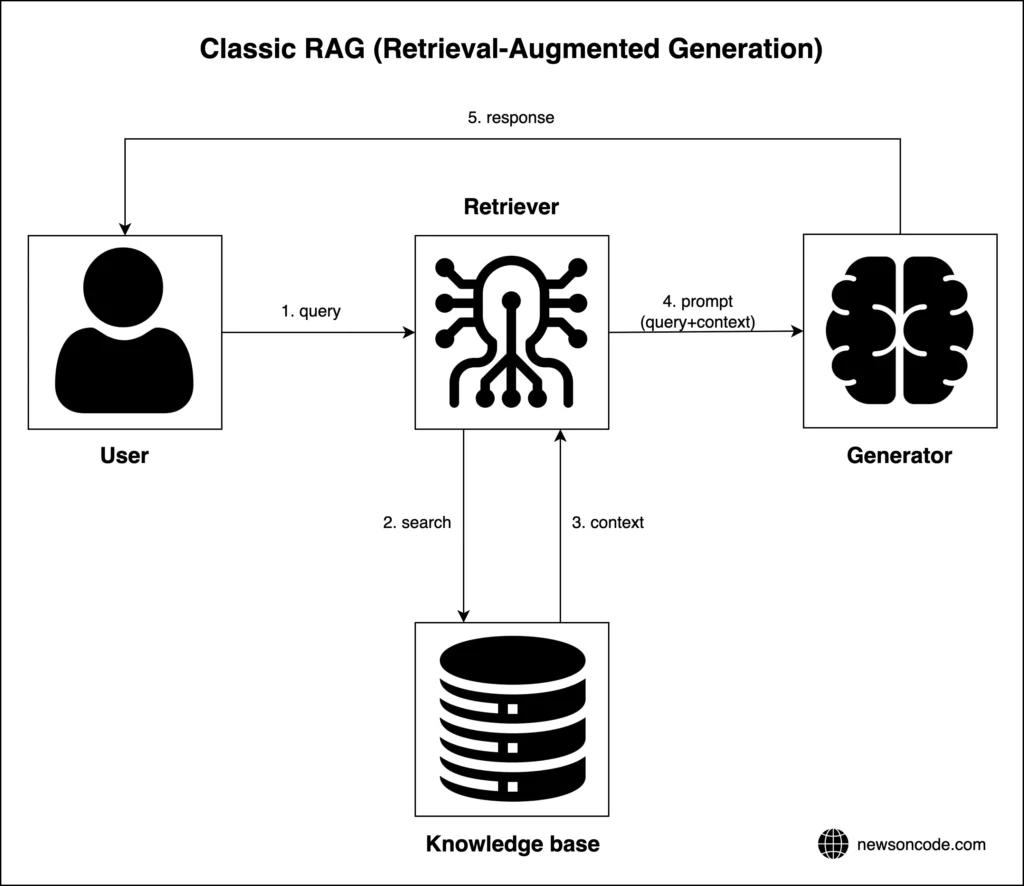
The field of artificial intelligence (AI) is undergoing a transformative shift with the emergence of Retrieval-Augmented Generation (RAG). As we progress through 2025, RAG has become a cornerstone for creating smarter, more reliable AI systems. By bridging the gap between static, pre-trained AI models and dynamic, real-time information retrieval, RAG offers unparalleled potential for businesses and developers. This comprehensive guide explores the essence of Classic RAG and its profound impact on modern AI applications.
What Is Classic RAG and Why Is It a Game-Changer?
Classic RAG redefines how AI systems access and utilize information. Unlike traditional AI systems that rely solely on pre-trained datasets, RAG introduces the ability to retrieve and integrate real-time data from external knowledge sources. This unique capability significantly enhances response accuracy, ensuring relevance and reliability for diverse applications.
The Core Components of RAG
Classic RAG is built on two foundational modules: the Retriever System and the Generator Module.
1. Retriever System
- Intelligent Search Functionality: Performs advanced searches to identify relevant information.
- Real-Time Data Access: Retrieves up-to-date knowledge from external databases or knowledge bases.
- Context-Aware Filtering: Filters retrieved data to ensure it aligns with the query.
- Seamless Knowledge Base Integration: Interfaces with structured and unstructured knowledge sources.
2. Generator Module
- Natural Language Processing (NLP): Generates responses that feel natural and human-like.
- Context-Sensitive Response: Combines the query and retrieved knowledge for precise output.
- Accuracy Optimization: Refines responses to minimize misinformation.
- Quality Control Mechanisms: Ensures responses meet predefined quality benchmarks.
How Does Classic RAG Work?
The workflow of RAG involves five structured steps:
- Query Processing: The user inputs a query, which is analyzed by the system.
- Knowledge Retrieval: Relevant data is identified and retrieved from the knowledge base.
- Context Integration: The retrieved information is combined with the original query.
- Response Generation: The AI processes the integrated data to generate a comprehensive response.
- Output Delivery: The final response is delivered to the user.
Below is a diagram illustrating the process:

Benefits of Implementing RAG Technology
1. Enhanced Accuracy
RAG cross-references multiple data sources to reduce the likelihood of errors, hallucinations, or misinformation.
2. Real-Time Updates
Unlike static AI models, RAG dynamically incorporates the latest information, making it ideal for fast-paced industries.
3. Scalability
Organizations can scale RAG systems to accommodate increasing data volumes and user demands without sacrificing performance.
Best Practices for RAG Implementation
To maximize the potential of RAG, consider these best practices:
Regular Knowledge Base Updates
- Continuously add fresh, relevant data.
- Remove outdated or inaccurate information.
- Ensure data sources are credible.
Performance Optimization
- Monitor system response times.
- Fine-tune retrieval mechanisms.
- Balance speed and accuracy for optimal results.
Quality Assurance
- Establish rigorous testing protocols.
- Regularly review response accuracy.
- Gather user feedback to improve system performance.
Future Trends in RAG Technology
As RAG continues to evolve, several exciting trends are shaping its future:
- Enhanced Integration: Improved interoperability with third-party systems like APIs and databases.
- Advanced Personalization: Systems capable of tailoring responses to individual users.
- Improved Context Understanding: Enhanced algorithms for analyzing user intent and nuances.
- Stronger Security Measures: Robust safeguards to protect sensitive data.
Practical Applications of Classic RAG
Business Applications
- Customer Support: Automates customer service with contextually accurate responses.
- Market Research: Analyzes real-time trends for strategic decision-making.
- Content Generation: Creates contextually rich and relevant content.
- Decision Support Systems: Provides actionable insights for business operations.
Technical Implementation
- API Integration: Seamlessly integrates RAG systems into existing workflows.
- Database Management: Leverages structured and unstructured data effectively.
- System Optimization: Ensures consistent performance under high user demand.
- Performance Monitoring: Tracks metrics to refine system functionality.
Conclusion
Classic RAG represents a monumental advancement in AI, empowering businesses to deliver accurate, real-time, and scalable solutions. By understanding and implementing RAG effectively, organizations can harness its potential to remain competitive in an AI-driven landscape. As 2025 progresses, staying ahead of these trends will be crucial for leveraging the full capabilities of Retrieval-Augmented Generation.